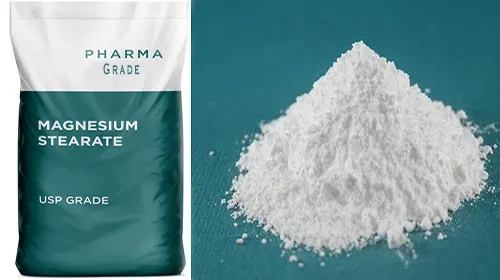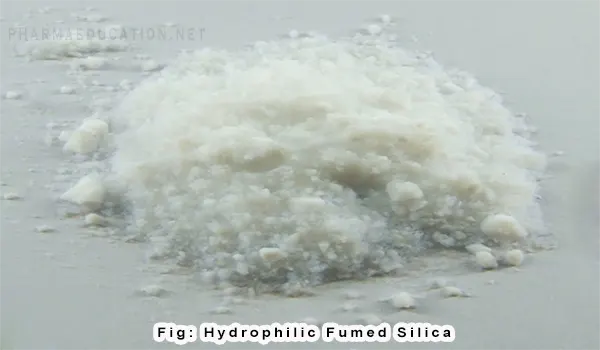Lubricant and Glidant are two important excipients in solid dosage manufacturing especially tablets. Typically, these two materials have overlapping functions, thus, sometimes make confusion. The differentiation between these terms lubricant and glidant are as follows:
Table of Contents
What is the definition of Lubricant vs Glidant?
Lubricant is a non-toxic, pharmacologically inactive substance added to the formulation to decrease friction between the tablet’s surface and the die wall cavity in which the tablet was formed and to reduce wear and tear of dies and punches. Probably, it is hard to produce a proper tablet without lubricant. Also, various specialist defines the lubricants as below:
Lubricant is a compound added in tablet formulations primarily to reduce friction between the die wall and granules as the tablet is formed and ejected [1].
A lubricant may be defined as a suitable material, a small amount of which interposed between two rubbings surfaces will decrease friction arising at the interface [2, 3].
On the other hand, glidant is a non-toxic, pharmacologically inactive substance used to optimize the flow properties of tablet granulation or powder materials by decreasing interparticle friction and cohesion. At a certain range of concentrations, only a glidant may work such as talc 5%. Generally, glidant may inhibit the flow properties above a certain concentration.
How do Lubricant and Glidant Work (Mechanism of Action)?
Generally, solid particle surfaces are not smooth, they consist of irregularities known as asperities. When two solid material particles in contact are displaced relative to each other and parallel to the plane of contact, resistance is known as friction [4, 5]. This friction or asperities may be responsible for decreasing flow-ability and interrupting the smooth ejection of the tablet from the die cavity.
Friction can be reduced by adding a continuous film of lubricants to the moving surfaces or by boundary films. Lubricants produce a film layer in between granules. When the lubricant is thought to offer a lower shear interface than that characteristic of the die wall tablet surfaces and will thus readily shear when tangential motion is initiated between the tablets and die during the ejection process [6].
Fluid lubrication would help in the easy ejection of a tablet but the tackiness of the tablet and reduction of tablet strength are drawbacks of fluid lubricants. Boundary lubricants are more commonly used than fluid lubricants [7].
On the other hand, a glidant’s effect is due to a counter-action to factors resulting in poor flowability of powders. Besides, glidant increases powder flow properties by correcting surface irregularity, reducing interparticular friction as well as decreasing surface charge.
Classification of Lubricant vs Glidant
Firstly, Based on Solubility, Lubricants are two types:
a) Water soluble
Generally, they are poor lubricants and they have no glidant or anti-adherent properties. For example, Boric acid, Sodium oleate, Sodium Benzoate, Sodium Lauryl Sulphate, Sodium Acetate and Magnesium Lauryl Sulphate etc.
b) Water insoluble
Most widely used lubricants are water-insoluble. Generally, they are good lubricants and many of them have both glidant and anti-adherent properties. In addition, they are effective at relatively low concentrations. For example, Calcium stearate, magnesium stearate, Sterotex, Talc, and Sterowet etc.

Secondly, Based on the Nature of the materials, Lubricants are 2 types:
Solid: For example, Calcium Stearate, Magnesium Stearate, and Talc etc.
Liquid: For example, liquid paraffin.
On the other hand, Based on Solubility Glidant are two types:

Hydrophilic: For example, hydrophilic silica and hydrophilic colloidal silicon dioxide [8].
Hydrophobic: For example, hydrophobic silica and hydrophobic colloidal silicon dioxide.
Advantages of Lubricant and Glidant
Lubricant
- Smooth ejection of tablet from die cavity by reducing inter-particle friction.
- Prevent the adhesion of the tablet.
- Many lubricants may improve flowability
- Reducing wear on rubbing surfaces [9].
- High resistance to deterioration in storage.
- Highly stable.
Glidant
- Smooth flow of powder or granules during solid dosage from manufacturing.
- Helps to maintain uniformity of powder mixture of API and/or excipients.
- Indirectly prevent weight variation.
Disadvantages of Lubricant and Glidant
Lubricant
- Careful selection is necessary since some lubricants may interact adversely when in combination; for example, magnesium stearate and talc [10].
- Lubricants at higher concentrations may induce tableting problems such as capping, and lamination.
- Some lubricants are the production of oil spots. For example, stearic acid salts and derivatives. [11].
- Higher coefficient friction.
- Improper mixing of lubricant affects tablet hardness.
Glidant
- At a certain range of concentrations, only a glidant will work. Above a certain concentration, the glidant will inhibit flow properties.
- Besides, they have no ability to reduce die wall friction.
Mixing Time Range of Lubricant and Glidant
Generally, the Lubricant mixing time is too short (2-5 minutes). For example, the most widely used lubricant, Magnesium Stearate is added to the blend for 2-5 minutes prior to the conclusion of the blending period [12]. While Glidant mixing time is higher than lubricant mixing time.
Effect of High Mixing Time of Lubricant and Glidant
Generally, the high mixing time of lubricant may decrease the tablet’s hardness [13]. On the other hand, the high mixing time of glidant does not affect tablet quality except for excessively high mixing time. But, the short mixing time of glidant cannot produce good flow ability.
Mixing order of Lubricant and Glidant
Typically, Lubricant is added to the final blend. Simply, it is the last stage of mixing before compression. On the other hand, Glidant is added either in the final blend or before wet granulation or spray granulation, sometimes, in combination with lubricant.
Pharmaceutical applications
Applications of Lubricant
- Smooth ejection of tablet from die cavity by reducing inter-particle friction.
- Lubricant may prevent adherence of tablet to the die wall thus no sticking of granules to the tooling.
- Also, Lubricant may improve granule’s flow properties.
Applications of Glidant
- The most noteworthy application is to improve powder flow properties.
- To reduce the cohesion
- Correcting surface irregularity
- Decreasing surface charge
Examples of Lubricant and Glidant
Lubricant
The most widely used lubricant is Magnesium stearate for tablets. Probably, Talc is the second most commonly used lubricant but Talc at a 5% concentration is used as a glidant [11]. The most commonly used lubricants are [14]:
- Magnesium stearate
- Magnesium silicate
- Calcium stearate
- Stearic acid,
- Talc [15]
- Sodium Lauryl Sulphate
- Magnesium Lauryl Sulphate
Glidant
- Corn Starch 5-10%
- Talc 5%
- Colloidal Silica such as Cab-O-Sil, Syloid, or Aerosil in 0.25-3% [11]
In short, the difference between Lubricant and Glidant
| Features | Lubricant | Glidant |
| Definition | Lubricant is a non-toxic, pharmacologically inactive substance added to the formulation to decrease friction between a tablet’s surface and the die wall cavity in which the tablet was formed and reduce wear and tear of dies and punches. | Glidant is a non-toxic, pharmacologically inactive substance used to optimize the flow properties of tablet granulation or power materials by decreasing interparticle friction and cohesion. |
| Mechanism of Action | Friction may reduce by adding a continuous film of lubricant to the moving surfaces or by boundary films. | Correcting surface irregularity, reducing interparticular friction and decreasing surface charge. |
| Classification | Based on solubility lubricants are two types: a) Water soluble b) Water insolubleAlso, based on nature, lubricants are 2 types: a) Solid b) Liquid | They have no such established classification but they are also two types: a) Hydrophilic b) HydrophobicCertainly, Glidant is only in solid form. |
| Advantage | a) Smooth ejection of tablet from the die cavity by reducing inter-particle friction. b) Prevent the adhesion of the tablet. c) Many lubricants may improve flowability d) Reducing wear on rubbing surfaces | a) Smooth flow of powder or granules during solid dosage from manufacturing. b) Helps to maintain uniformity of powder mixture of API and/or excipients. c) Indirectly prevent weight variation. |
| Disadvantage | Lubricants at higher concentrations may induce tableting problems such as capping, and lamination. | At a certain range of concentrations, only a glidant will work and they have no ability to reduce die wall friction. |
| Mixing Time Range | Generally, Lubricant mixing time is too short (2-5 minutes). | Glidant mixing time is higher than lubricant mixing time. |
| Effect of High Mixing Time | The high mixing time of lubricant may decrease the tablet’s hardness. | The high mixing time of glidant does not affect tableting quality except for excessively high mixing time. But, the short mixing time of glidant cannot produce good flow ability. |
| Mixing order | Typically, Lubricant is added to the final blend. | Glidant is added to the blend prior to mixing lubricants, sometimes, in combination with lubricant. In addition, glidant is added before wet granulation or spray granulation. |
| Pharmaceutical Application | To smooth ejection of tablet from die cavity by reducing inter-particle friction. | To improve powder flow |
| Example | Magnesium stearate, Magnesium silicate, Calcium stearate, Stearic acid, and Talc etc. | Colloidal Silica such as Cab-O-Sil, Syloid, or Aerosil in 0.25-3%, Corn Starch 5-10%, and, Talc 5% etc. |
Enthusiast visitors are also reading:
- First, Difference between Sterile and Pyrogen-free
- Second, Difference between Drugs and Medicine
- Third, Difference between Packing and Packaging
- Fourth, Difference between Pharmacokinetics and Pharmacodynamics
References
| 1. | Sprowl, Sprowl’s American Pharmacy, 7th edn. J.B. Lippincott, Philadelphia-Toronto, 1974 |
| 2. | Strickland, W.A., Jr., Higuchi, T. and Busse, L.W., The physics of tablet compression. J. Am. Pharm. Ass. 1960; 35-40 |
| 3. | Komarek, K.R., Selecting binders and lubricants for agglomeration processes. Cllcm. Eng. 1967; 154-155. |
| 4. | Bowdcn, F.P. and Tabor, D., In Friction and Lubrication of Solids, Clarendon Press, Oxford. 1958 |
| 5. | Bowden, F.P. and Tabor, D., In Friction and Lubrication, Methuen, London, 1967 |
| 6. | Bhavdip Faldu1 and Bansi Zalavadiya. Lubricants: Fundamentals of Tablet Manufacturing. IJRPC. 2012; 2(4) |
| 7. | Wang J, Wen H, Desai D. Lubrication in tablet formulations. Eur J Pharm Biopharm. 2010; 75 (1):1–15. |
| 8. | Ahmad Fahmi Bin Ruzaidi, Uttam Kumar Mandal Bappaditya Chatterjee; Glidant effect of hydrophobic and hydrophilic nanosilica on a cohesive powder: Comparison of different flow characterization techniques. Particuology, April 2017, Volume 31, Pages 69-79 |
| 9. | Silversher H I. Materials for lubrication applications. Spec publ.sp-3051; 1969:199-239. |
| 10. | Buckley D. H., Johnson R L. Lubrication with solids. chem Technol;1972: 302-310. |
| 11. | Lachman, Lieberman, H.A. and Kanig, J.L., In Theory and Practice of Industrial Pharmacy, Lea and Febiger, New York, 2nd edn., 1970. |
| 12. | Closs, S. José, Yves Roy, Jason Boodram, Sanjay Samudre, Murray John Adams, Colin M. Minchom and Nancy L. Mathis. “Effect of Magnesium Stearate on a Pharmaceutical Blend Using Thermal Effusivity.” 2004. |
| 13. | Kikuta J, Kitamori N. Effect of mixing time on the lubricating properties of magnesium stearate and the final characteristics of the compressed tablets. Drug Dev. Ind. Pharm. 1994; 20:343–355. |
| 14. | Raymond Crowe paul, J Shakey and Marian E Quinn, eds. Handbook of pharmaceutical excipient, Edition 6th, edited by Publisher- Pharmaceutical Press and American Pharmacists Association. |
| 15. | Dawoodbhai S, Rhodes CT. Pharmaceutical and cosmetic uses of talc. Drug Dev Ind Pharm 1990; 16: 2409–2429. |
Thanks PharmaEducation, Very clear and details information about lubricant and glidant. I hope you may create more post regarding pharmaceuticals.